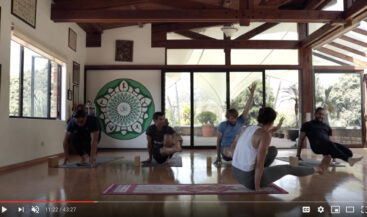I recently went to a Vipassana meditation class and was left to contemplate the importance of mindful meditation in our busy lives. Mindfulness has become a popular topic as of late, but what does it really mean to be mindful? By now I’m sure you’ve heard of the term monkey mind, used to illustrate our overactive, uncontrollable mind that jumps from one thought to the next. It is said that we can have upwards of 50,000 thoughts a day! Most of these thoughts are on the past or future, not the here and now and more often than not gear towards the negative. The mind moves so quickly it feels impossible to pay attention to what lies beneath. We convince ourselves that the way we are feeling is normal without delving into what’s really going on. We see things through our experiences, our upbringings, societal norms that we are unable to see them as they really are. To placate ourselves we seek distractions – instant access and gratification. Fearing boredom, we have become addicted to technology, taking us further away from ourselves. Without learning to quiet the mind and be more present, we live our lives in autopilot, giving little thought to our actions resulting in unwanted repercussions. In Buddhism, it is said that we have six senses – the mind, our inner sense, being the last. In order to be mindful, we need to use all six senses to go within and pay attention to what is going on in this very moment. A part of buddhist traditions, Vipassana, which means “to see things as they really are”, helps us to create awareness through personal introspection so that we can know ourselves and the nature of our true reality. The more that we can learn to pay attention, the more we are able to become conscious. Vipassana uses four tools to create mindfulness: The Body: it uses the body as an anchor so that even if the mind wanders, the body remains present. It requires you to pay attention to your body in the present moment – what is it doing? How does it feel? The Senses: engaging in our senses, we pay attention to what we are hearing, smelling, seeing, feeling right this very moment. Are you hot or cold? How do your clothes feel to your skin? What sounds do you hear? We acknowledge those things without lingering on any one. The Mind: divided into three – agreeable, disagreeable, and neutral – we contemplate how the mind is feeling right now. The agreeable creates attachment; we want more and thus we linger on that pleasant thought, losing sight of what’s happening at present. The disagreeable makes us want to reject or react negatively to the thought or what’s going on, keeping us from seeing what’s beneath, from learning the lesson beyond the bad. The neutral is neither here nor there. Regardless of the state of the mind, we simply acknowledge where we are and let it be. Objects of the Mind: are the emotions that trap us. Desire, anger, hurt, and so forth. They keep taking us away from the present moment back to the past or looking forward to the future. Using these tools, recognise what is going on without trying to control it. The more you watch yourself, awareness helps to create change. You will start to see things as they truly are by being present, aware, mindful and attentive in the now. When I tried Vipassana meditation for the first time, my mental state was one of disagreement. I was uncomfortable. I felt time was going by so slowly. I started to feel a bit claustrophobic and anxious. My teacher told me that this was good – I was paying attention to how I was feeling and these feelings simply were. I should acknowledge them and let them be. The difficulty is further proof of the lack of control we have over things. He told me that if I evade what I am feeling, I will never be able to deal with it or go beyond it. Nobody came and gave us anxiety, we gave it to ourselves. Sometimes just recognising that feeling can help to eliminate it or uncover what is beneath it. This moment changed meditation and the understanding of mindfulness for me. Meditation is a process – start small and pay attention. An example of how to experience this form of meditation is to find a comfortable seated position, placing your right hand over the left and connecting your thumb tips together. Start to inhale and exhale deeply, paying attention to your stomach as it expands and contracts. As it expands, say to yourself “out” and as it contracts you say to yourself “in”. As thoughts enter the mind, recognise them, name them (“distracted”, “pain in my back”, “cold”, “runny nose”) and then return to your breathing and the repetition of in and out. Breathing is the anchor that brings you into the now. Use it like the gift that it is and be present to the life you are living.
Live With Attention, Not Tension





